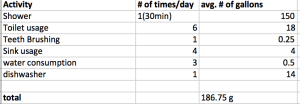After living in Branchburg, New Jersey for 18 years I’ve never quite known where my water came from. Being close to New York my town used city water. The city water originally came from rivers including the Raritan River, Millstone River, Delaware and Raritan Canal and about 130 wells. The water treatment center from American Water pumps approximately 145 gallons to the surrounding towns. This water goes through a series of underground pipes connected to the water plant. Before the reservoir, however, the water must go through a series of filtration systems in order to remove any contaminants. This filtration system often includes the use of chlorine and magnesium and calcium ions to bond with and capture biological contaminants. After the water comes from the tap, toilet (etc…) water is used and disposed of down the pipes it is taken to the regional sewage treatment plant, in my case Somerset Raritan Sewage and properly disposed of from there.
When figuring out how much water I use each day, I found that I use the most during my showers. However, since downtown State College apartments tend to be quite old I would assume my shower head is not water saving, therefore letting out 16 gallons per minute..(“Ouch”, says the Environment). So taking a 30 minute (more or less) takes up about 150 gallons. After cutting that out, I asked my roommates to refrain from running the dishwasher until it was completely full, that saved about 16 gallons. Next, I made sure I turned the sink on as little as possible during tooth brushing and hand washing which required some major quick reflex usage. Luckily, I don’t drink much water anyway, just because I am forgetful, so that was easy to cut down…I will admit I was pretty thirsty and just sipped on the water to make it seem like I was drinking more. The final usage was the toilet… however, I am not sure the “if it’s yellow, let it mellow” way to live is for public spaces in my mind. In conclusion, in order to cut back on water more, I can use more quick reflexes to turn the water off quickly as well as try to cut down of luxury showers/taking one every day. As for toilet water usage, many of the toilets in my building have 2 settings for “how much water needs to be used”, so making sure I use the correct option can really make a difference.


Like you, I realized that the shower is the most wasteful aspect of our water usage. Though I don’t know how practical or cost effective this would, I think a closed loop/recycle system of the tap water would greatly help reduce excess waste (assuming filter is in place). Also, emphasizing conservation of water with roommates is a coin toss in persuading people other than oneself to conserve water because their actions don’t directly impact you in a physical sense (outside of utility bill). Another development regarding restrooms is the implementation of waterless urinals that reduce water usage. Lastly, here is my blog.http://geog030.dutton.psu.edu/2016/02/13/module-4-9/
Like you, I realized that the shower is the most wasteful aspect of our water usage. Though I don’t know how practical or cost effective this would, I think a closed loop/recycle system of the tap water would greatly help reduce excess waste (assuming filter is in place). Also, emphasizing conservation of water with roommates is a coin toss in persuading people other than oneself to conserve water because their actions don’t directly impact you in a physical sense (outside of utility bill). Another development regarding restrooms is the implementation of waterless urinals that reduce water usage.
It is really quite surprising when you realize how much water we really waste. I always thought I was pretty conscious of it but until you really write it out, it doesn’t really register. My wife and I have begun taking steps to minimize our usage even more by installing water saving shower heads and trying to use less water when hand washing dishes. We even installed water saving toilets that use about 20-30% less water than traditional toilets.